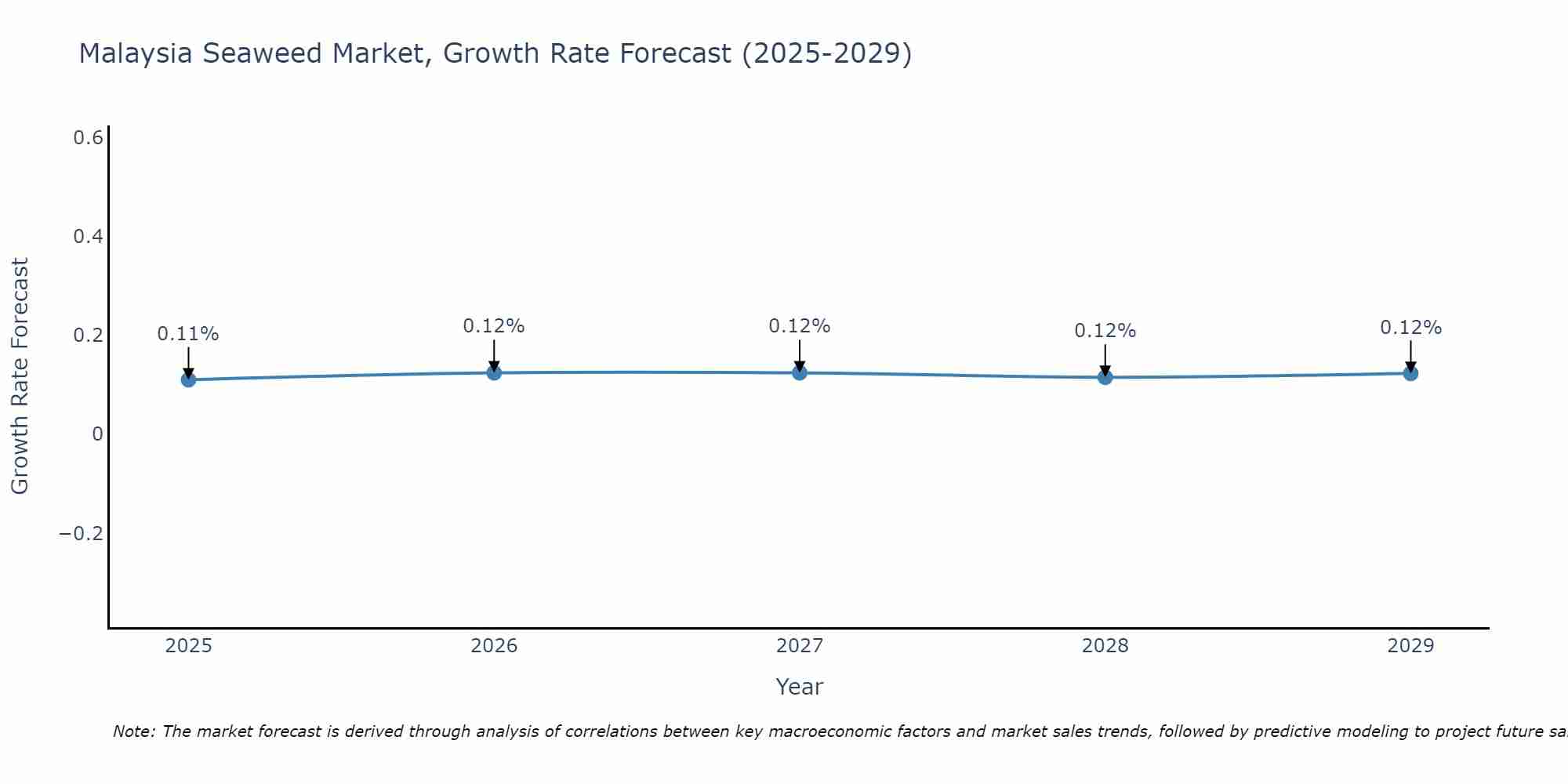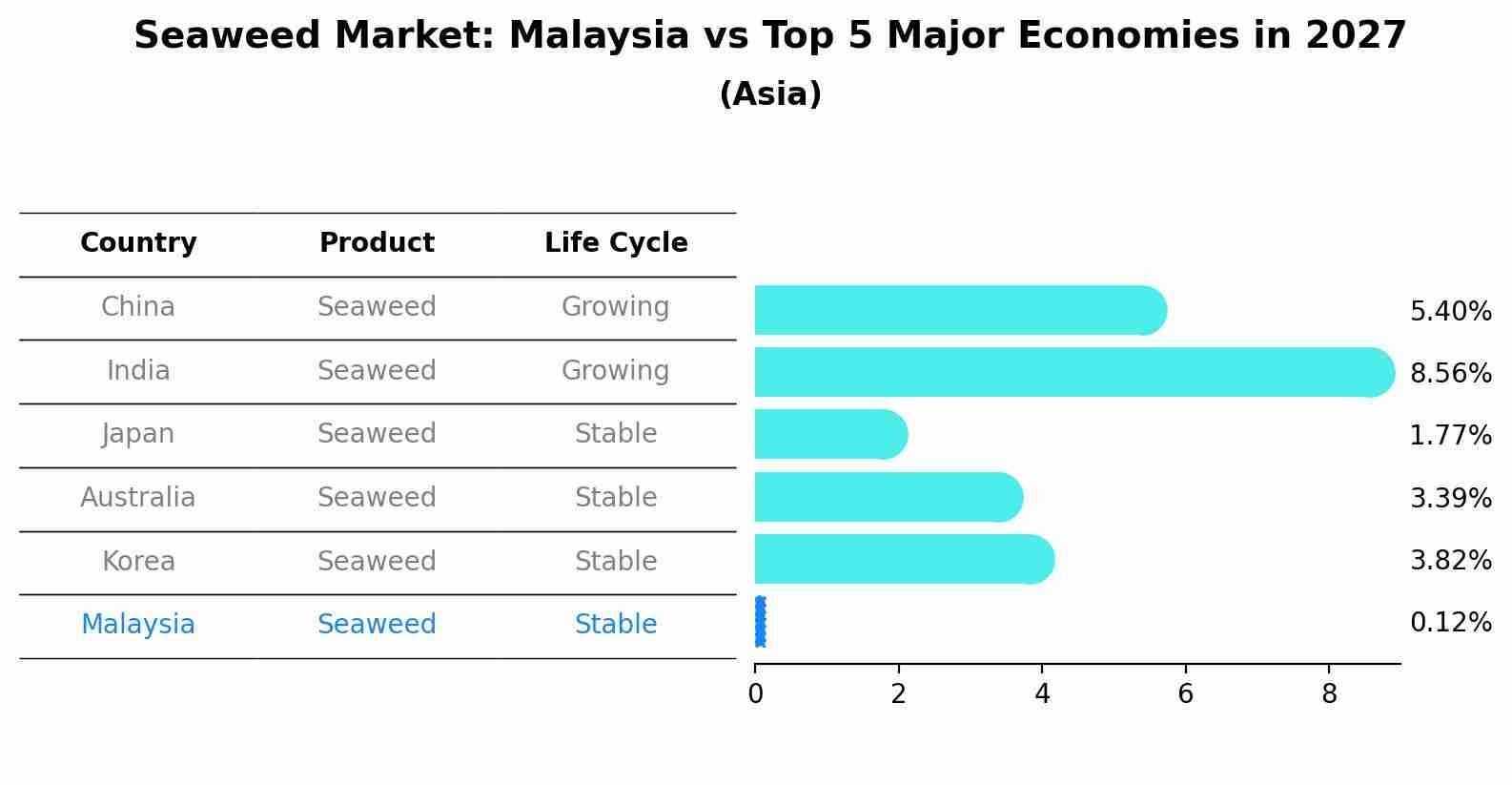Malaysia Seaweed Market (2025-2031) Outlook | Size, Industry, Revenue, Trends, Companies, Growth, Value, Share, Analysis & Forecast
| Product Code: ETC304886 | Publication Date: Aug 2022 | Updated Date: Aug 2025 | Product Type: Market Research Report | |
| Publisher: 6Wresearch | Author: Ravi Bhandari | No. of Pages: 75 | No. of Figures: 35 | No. of Tables: 20 |
Malaysia Seaweed Market Size Growth Rate
The Malaysia Seaweed Market is projected to witness mixed growth rate patterns during 2025 to 2029. The growth rate begins at 0.11% in 2025, climbs to a high of 0.12% in 2027, and moderates to 0.12% by 2029.

Seaweed Market: Malaysia vs Top 5 Major Economies in 2027 (Asia)
The Seaweed market in Malaysia is projected to grow at a stable growth rate of 0.12% by 2027, within the Asia region led by China, along with other countries like India, Japan, Australia and South Korea, collectively shaping a dynamic and evolving market environment driven by innovation and increasing adoption of emerging technologies.

Malaysia Seaweed Market Synopsis
The Malaysia seaweed market is witnessing a surge in demand, mainly due to its increasing usage in the food and cosmetics industries. Seaweed is recognized for its nutritional value and sustainability, making it a popular choice among health-conscious consumers. Moreover, the cosmetics industry utilizes seaweed extracts for various skincare products. The market is expected to continue growing as consumers seek out natural and organic ingredients in their daily lives.
Drivers of the Market
The Malaysia seaweed market is poised for significant growth in the coming years. Several drivers are contributing to this positive outlook. Firstly, there is a rising global demand for seaweed-based products, particularly in the food and cosmetic industries, owing to their health benefits and sustainability. Malaysia strategic geographical location, abundant coastline, and favorable climate for seaweed cultivation make it well-positioned to tap into this growing market. Additionally, government initiatives to promote seaweed farming and processing, along with increasing awareness among consumers about the nutritional value of seaweed, are expected to boost the industry further. This presents opportunities for both existing players and new entrants to expand their presence in the Malaysia seaweed market.
Challenges of the Market
The Malaysia seaweed market faces challenges related to sustainability and market acceptance. Sustainable seaweed farming practices are essential to preserve marine ecosystems, but they require careful management and investment. Market acceptance is another hurdle, as seaweed products may not yet be mainstream in Malaysia cuisine. Educating consumers about the nutritional benefits and culinary versatility of seaweed can be a continuous challenge. Moreover, quality control and consistency in seaweed products are vital for market growth, as variations in taste and texture can impact consumer preferences.
COVID 19 Impact on the Market
The Malaysia seaweed market has witnessed steady growth in recent years, driven by increasing demand for seaweed-based products in various industries, including food, cosmetics, and pharmaceuticals. However, the COVID-19 pandemic posed significant challenges to the industry. Supply chain disruptions and reduced workforce availability hampered production and distribution, leading to temporary setbacks. Nevertheless, as the world gradually recovers from the pandemic, the market is expected to rebound. Consumers` growing awareness of the health benefits of seaweed and its sustainability credentials are likely to drive future growth in the industry.
Key Players in the Market
The Malaysia seaweed market is expected to expand due to the increasing demand for seaweed-based products in the food and cosmetics industries. Notable producers include Agar-Agar UDANG, Green Cotton Sdn Bhd, and Seaweed Club. These companies will focus on sustainable harvesting and product innovation.
Key Highlights of the Report:
- Malaysia Seaweed Market Outlook
- Market Size of Malaysia Seaweed Market, 2024
- Forecast of Malaysia Seaweed Market, 2031
- Historical Data and Forecast of Malaysia Seaweed Revenues & Volume for the Period 2021-2031
- Malaysia Seaweed Market Trend Evolution
- Malaysia Seaweed Market Drivers and Challenges
- Malaysia Seaweed Price Trends
- Malaysia Seaweed Porter's Five Forces
- Malaysia Seaweed Industry Life Cycle
- Historical Data and Forecast of Malaysia Seaweed Market Revenues & Volume By Product for the Period 2021-2031
- Historical Data and Forecast of Malaysia Seaweed Market Revenues & Volume By Red for the Period 2021-2031
- Historical Data and Forecast of Malaysia Seaweed Market Revenues & Volume By Brown for the Period 2021-2031
- Historical Data and Forecast of Malaysia Seaweed Market Revenues & Volume By Green for the Period 2021-2031
- Historical Data and Forecast of Malaysia Seaweed Market Revenues & Volume By Application for the Period 2021-2031
- Historical Data and Forecast of Malaysia Seaweed Market Revenues & Volume By Human Food for the Period 2021-2031
- Historical Data and Forecast of Malaysia Seaweed Market Revenues & Volume By Hydrocolloids for the Period 2021-2031
- Historical Data and Forecast of Malaysia Seaweed Market Revenues & Volume By Fertilizers for the Period 2021-2031
- Historical Data and Forecast of Malaysia Seaweed Market Revenues & Volume By Animal Feed Additives for the Period 2021-2031
- Historical Data and Forecast of Malaysia Seaweed Market Revenues & Volume By Others for the Period 2021-2031
- Malaysia Seaweed Import Export Trade Statistics
- Market Opportunity Assessment By Product
- Market Opportunity Assessment By Application
- Malaysia Seaweed Top Companies Market Share
- Malaysia Seaweed Competitive Benchmarking By Technical and Operational Parameters
- Malaysia Seaweed Company Profiles
- Malaysia Seaweed Key Strategic Recommendations
Frequently Asked Questions About the Market Study (FAQs):
1 Executive Summary |
2 Introduction |
2.1 Key Highlights of the Report |
2.2 Report Description |
2.3 Market Scope & Segmentation |
2.4 Research Methodology |
2.5 Assumptions |
3 Malaysia Seaweed Market Overview |
3.1 Malaysia Country Macro Economic Indicators |
3.2 Malaysia Seaweed Market Revenues & Volume, 2021 & 2031F |
3.3 Malaysia Seaweed Market - Industry Life Cycle |
3.4 Malaysia Seaweed Market - Porter's Five Forces |
3.5 Malaysia Seaweed Market Revenues & Volume Share, By Product, 2021 & 2031F |
3.6 Malaysia Seaweed Market Revenues & Volume Share, By Application, 2021 & 2031F |
4 Malaysia Seaweed Market Dynamics |
4.1 Impact Analysis |
4.2 Market Drivers |
4.2.1 Increasing awareness about the health benefits of seaweed consumption |
4.2.2 Growing demand for natural and organic food products |
4.2.3 Favorable government policies supporting seaweed cultivation and production |
4.3 Market Restraints |
4.3.1 Seasonal variations affecting seaweed cultivation and harvest |
4.3.2 Lack of standardized quality control measures in the industry |
4.3.3 Competition from other sources of plant-based alternatives |
5 Malaysia Seaweed Market Trends |
6 Malaysia Seaweed Market, By Types |
6.1 Malaysia Seaweed Market, By Product |
6.1.1 Overview and Analysis |
6.1.2 Malaysia Seaweed Market Revenues & Volume, By Product, 2021-2031F |
6.1.3 Malaysia Seaweed Market Revenues & Volume, By Red, 2021-2031F |
6.1.4 Malaysia Seaweed Market Revenues & Volume, By Brown, 2021-2031F |
6.1.5 Malaysia Seaweed Market Revenues & Volume, By Green, 2021-2031F |
6.2 Malaysia Seaweed Market, By Application |
6.2.1 Overview and Analysis |
6.2.2 Malaysia Seaweed Market Revenues & Volume, By Human Food, 2021-2031F |
6.2.3 Malaysia Seaweed Market Revenues & Volume, By Hydrocolloids, 2021-2031F |
6.2.4 Malaysia Seaweed Market Revenues & Volume, By Fertilizers, 2021-2031F |
6.2.5 Malaysia Seaweed Market Revenues & Volume, By Animal Feed Additives, 2021-2031F |
6.2.6 Malaysia Seaweed Market Revenues & Volume, By Others, 2021-2031F |
7 Malaysia Seaweed Market Import-Export Trade Statistics |
7.1 Malaysia Seaweed Market Export to Major Countries |
7.2 Malaysia Seaweed Market Imports from Major Countries |
8 Malaysia Seaweed Market Key Performance Indicators |
8.1 Average selling price of seaweed products |
8.2 Number of seaweed farms and production capacity |
8.3 Research and development investment in new seaweed products |
8.4 Consumer perception and acceptance of seaweed as a food source |
8.5 Environmental sustainability practices in seaweed cultivation and processing |
9 Malaysia Seaweed Market - Opportunity Assessment |
9.1 Malaysia Seaweed Market Opportunity Assessment, By Product, 2021 & 2031F |
9.2 Malaysia Seaweed Market Opportunity Assessment, By Application, 2021 & 2031F |
10 Malaysia Seaweed Market - Competitive Landscape |
10.1 Malaysia Seaweed Market Revenue Share, By Companies, 2024 |
10.2 Malaysia Seaweed Market Competitive Benchmarking, By Operating and Technical Parameters |
11 Company Profiles |
12 Recommendations |
13 Disclaimer |
- Single User License$ 1,995
- Department License$ 2,400
- Site License$ 3,120
- Global License$ 3,795
Search
Thought Leadership and Analyst Meet
Our Clients
Related Reports
- Canada Oil and Gas Market (2026-2032) | Share, Segmentation, Value, Industry, Trends, Forecast, Analysis, Size & Revenue, Growth, Competitive Landscape, Outlook, Companies
- Germany Breakfast Food Market (2026-2032) | Industry, Share, Growth, Size, Companies, Value, Analysis, Revenue, Trends, Forecast & Outlook
- Australia Briquette Market (2025-2031) | Growth, Size, Revenue, Forecast, Analysis, Trends, Value, Share, Industry & Companies
- Vietnam System Integrator Market (2025-2031) | Size, Companies, Analysis, Industry, Value, Forecast, Growth, Trends, Revenue & Share
- ASEAN and Thailand Brain Health Supplements Market (2025-2031) | Strategy, Consumer Insights, Analysis, Investment Trends, Opportunities, Growth, Size, Share, Industry, Revenue, Segments, Value, Segmentation, Supply, Forecast, Restraints, Outlook, Competition, Drivers, Trends, Demand, Pricing Analysis, Competitive, Strategic Insights, Companies, Challenges
- ASEAN Bearings Market (2025-2031) | Strategy, Consumer Insights, Analysis, Investment Trends, Opportunities, Growth, Size, Share, Industry, Revenue, Segments, Value, Segmentation, Supply, Forecast, Restraints, Outlook, Competition, Drivers, Trends, Demand, Pricing Analysis, Competitive, Strategic Insights, Companies, Challenges
- Europe Flooring Market (2025-2031) | Outlook, Share, Industry, Trends, Forecast, Companies, Revenue, Size, Analysis, Growth & Value
- Saudi Arabia Manlift Market (2025-2031) | Outlook, Size, Growth, Trends, Companies, Industry, Revenue, Value, Share, Forecast & Analysis
- Uganda Excavator, Crane, and Wheel Loaders Market (2025-2031) | Strategy, Consumer Insights, Analysis, Investment Trends, Opportunities, Growth, Size, Share, Industry, Revenue, Segments, Value, Segmentation, Supply, Forecast, Restraints, Outlook, Competition, Drivers, Trends, Demand, Pricing Analysis, Competitive, Strategic Insights, Companies, Challenges
- Rwanda Excavator, Crane, and Wheel Loaders Market (2025-2031) | Strategy, Consumer Insights, Analysis, Investment Trends, Opportunities, Growth, Size, Share, Industry, Revenue, Segments, Value, Segmentation, Supply, Forecast, Restraints, Outlook, Competition, Drivers, Trends, Demand, Pricing Analysis, Competitive, Strategic Insights, Companies, Challenges
Industry Events and Analyst Meet
Whitepaper
- Middle East & Africa Commercial Security Market Click here to view more.
- Middle East & Africa Fire Safety Systems & Equipment Market Click here to view more.
- GCC Drone Market Click here to view more.
- Middle East Lighting Fixture Market Click here to view more.
- GCC Physical & Perimeter Security Market Click here to view more.
6WResearch In News
- Doha a strategic location for EV manufacturing hub: IPA Qatar
- Demand for luxury TVs surging in the GCC, says Samsung
- Empowering Growth: The Thriving Journey of Bangladesh’s Cable Industry
- Demand for luxury TVs surging in the GCC, says Samsung
- Video call with a traditional healer? Once unthinkable, it’s now common in South Africa
- Intelligent Buildings To Smooth GCC’s Path To Net Zero


















